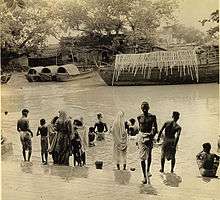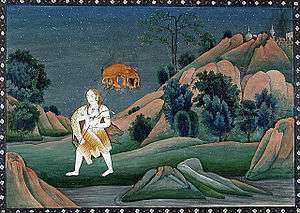Kalighat
| Kalighat | |
|---|---|
| Neighbourhood in Kolkata (Calcutta) | |
| Country |
|
| State | West Bengal |
| City | Kolkata |
| KMC Wards | 73, 83, 84 |
| Metro station | Kalighat metro station |
| Parliamentary constituency | Kolkata Dakshin |
| Assembly constituency | Bhabanipur |
| Elevation | 36 ft (11 m) |
| Time zone | IST (UTC+5:30) |
| PIN | 700 026 |
| Area code(s) | +91 33 |
Kalighat (Bengali: কালীঘাট) is a locality of Kolkata, India. One of the oldest neighbourhoods in South Kolkata, Kalighat is also densely populated and vibrant—with a rich history of cultural intermingling with the various foreign incursions into the area over time.
Kalighat Kalika

A famous temple Kalighat Kali Temple dedicated to the goddess Kali is situated in Kalighat. This is one of the 51 Shakti Peethas. The right toe of Dakshayani is said to have fallen here. The Shakti here is known as Kalika, while the Bhairava is Nakulesh. It is a very famous place and a pilgrimage for Shakta (Shiva and Durga/Kali/Shakti worshippers) followers within the Hindu religion. A lot of devoteed come everyday to worship Goddess Kali but it is found that Saturdays and Tuesdays are the days when maximum number of devotees turn up.

Kalika Temple
One Raja Basanta Krishna Roy Dev of South Indian descent, uncle of Pratapaditya and the King of Jessore, Bangladesh perhaps built what is now known as Old Temple. This temple was situated on the banks of river Adi Ganga. The natmandir, a hall attached to the sanctum sanctorum is in the southern side while Shiva's temple is situated in the north-east. There is also a temple dedicated to Radha Krishna built in 1843 by a zamindar of Baowali. The speciality of Kali of this temple is the long protruded tongue made of gold. This is a different appearance from the other visualisations of Kali.

Kalighat temple has references in 15th century texts. The original temple was a small hut. The present temple was built by the Sabarna Roy Choudhury family of Barisha in 1809. They offered 595 bighas of land to the Temple deity so that worship and service could be continued smoothly. It is believed by some scholars that the name Calcutta was derived from Kalighata. In the early days traders halted at Kalighat to pay patronage to the goddess. The temple was initially on the banks of Hooghly. The river over a period of time has moved away from the temple. The temple is now on the banks of a small canal called Adi Ganga, connecting to Hooghly. The present dakshina Kali idol of touchstone was created by two saints - Brahmananda Giri and Atmaram Giri. It was Padmabati Devi, the mother of Laksmikanta Roy Choudhury who discovered the fossils of Sati's finger in a lake called Kalikunda. This made Kalighat as one of the 51 Shakti Pithas.[1]
The Kalighat Temple as a Shakti Peeth

The shrine is revered as a Shakti Peetha by the Shaktism sect of Hinduism. The mythology of Daksha yaga[2] and Sati's self immolation is the story behind the origin of Shakti Peethas. Shakti Peethas are divine seats of Shakti formed due to the falling of body parts of the corpse of Sati Devi, when Lord Shiva carried it and wandered throughout Aryavartha in sorrow. There are 51 Shakti Peeth linking to the 51 alphabets in Sanskrit. Each temple have shrines for Shakti and Kalabhairava. The name of Shakti here is Kalika and the Kalabhairava as Nakuleshwar. It is believed that Sati Devi's Right Toes fell in Kalighat Shrine but as per some puranas the Mukha khanda or face of devi Sati fell in Kalighat.[3][4]
The great mythological texts including the Kalika Purana (Asthashakti) recognize the four major Shakti Peethas. Like (Bimala, Pada Khanda) inside the Jagannath Temple, Puri, Odisha, (Tara Tarini) Sthana Khanda (Breasts), near Brahmapur, Odisha, (Kamakshya, Yoni khanda) near Guwahati, Assam and (Dakhina Kalika, Mukha khanda) in Kolkata, West Bengal originated from the limbs of the Corpse of Mata Sati. In a hymn, the Kalika Purana (Asthashakti) clearly says:
[[“Vimala Pada khandancha,
Stana khandancha Tarini (Tara Tarini),
Kamakhya Yoni khandancha,
Mukha khandancha Kalika (Kali)
Anga pratyanga sangena
Vishnu Chakra Kshate nacha……”]]
Further explaining the importance of these four Peethas the Brihat Samhita gives the geographical location of these Peethas. For example:
“Rushikulya Tate Devi,
Tarakashya Mahagiri,
Tashya Srunge Stitha Tara,
Vasishta Rajitapara"
Thus, there is no dispute regarding these four Adi Shakti Peethas and their locations. These four Pithas are also believed as the most powerful shakti Pithas on earth. However, all these Four Adi Shakti Pithas are also part of 51 Shakti pithas but they are four major parts of Devi Sati's body So, they are important, powerful and believed as adi shakti pithas.
Kalika's Image
The image of the deity is incomplete. Only the face of the deity was made first. The hands, made of gold and silver, the tongue, the Shiva statue and all the jewellery were added over the years. On snanyatra day, while giving the divine Mother the ceremonial bath, the priests tie their eyes with cloth coverings. On auspicious occasions like Kali Puja, Durga Puja, Poila Boishakh, the Bengali New Year day and sankranti large number of devotees throng the place with offerings.
Adi Ganga
Kalighat was a Ghat (landing stage) sacred to Kali on the old course of the Hooghly river (Bhāgirathi). The name Calcutta is said to have been derived from the word Kalighat. The river over a period of time has moved away from the temple. The temple is now on the banks of a small canal called Adi Ganga which connects to the Hoogly. The Adi Ganga was the original course of the river Hoogly (the Ganges). Hence the name Adi (original) Ganges.
Kalighat painting

Kalighat painting, or pata (originally pronounced 'pot' in Bengali) is a style of Indian painting derives its name from the place. It is characterised by generously curving figures of both men and women and an earthy satirical style. It developed during the nineteenth century in response to the sudden prosperity brought to Calcutta by the East India Company trade, whereby many houses including that of 'Prince' Dwarkanath Tagore, grandfather of Rabindranath Tagore became incredibly wealthy. Many of these nouveau riche families came from not particular exalted caste backgrounds, so the orthodox tended to frown on them and their often very tasteless conspicuous consumption. To the common people the babus, as they were called, were equally objects of fun and sources of income. Thus the 'babu culture' portrayed in the Kalighat patas often shows inversions of the social order (wives beating husbands or leading them about in the guise of pet goats or dogs, maidservants wearing shoes, sahibs in undignified postures, domestic contretemps, and the like.) They also showed European innovations (babus wearing European clothes, smoking pipes, reading at desks, etc.). The object of this is only partly satirical; it also expresses the wonder that ordinary Bengalis felt on exposure to these new and curious ways and objects.
Kalighat pata pictures are highly stylised, do not use perspective, are usually pen and ink line drawings filled in with flat bright colours and normally use paper as a substrate, though some may be found with cloth backing or on cloth. The artists were rarely educated, and usually came from a lineage of artisans. Kalighat patas are still made today although genuine work is hard to come by. The art form is urban and largely secular: although gods and goddesses are often depicted, they appear in much the same de-romanticised way as the humans do. By contrast, the Orissa tradition of pata-painting, centering on Puri, is consciously devotional. Kalighat pata has been credited with influencing the Bengal School of art associated with Jamini Roy.
Kalighat in fiction
Amitav Ghosh's The Calcutta Chromosome is partly set in Kalighat and gives a wonderfully atmospheric depiction of the region as well as the city itself.
Kalighat also plays a prominent role in Song of Kali by Dan Simmons and in the short story Calcutta, Lord of Nerves by Poppy Z. Brite. It also features in the movie Kahaani starring Vidya Balan and directed by Sujoy Ghosh.
See also
References
- ↑ Bangiya Sabarna Katha Kalishetra Kalikatah by Bhabani Roy Choudhury, Manna Publication. ISBN 81-87648-36-8
- ↑ "Kottiyoor Devaswam Temple Administration Portal". http://kottiyoordevaswom.com/. Kottiyoor Devaswam. Retrieved 20 July 2013. External link in
|work=(help) - ↑ (Translator), F. Max Muller (June 1, 2004). The Upanishads, Vol I. Kessinger Publishing, LLC. ISBN 1419186418.
- ↑ (Translator), F. Max Muller (July 26, 2004). The Upanishads Part II: The Sacred Books of the East Part Fifteen. Kessinger Publishing, LLC. ISBN 1417930160.
Sabarna Prithivi - The Official website of the Sabarna Roy Choudhury Paribar Parishad
External links
| Wikimedia Commons has media related to Kalighat. |
- Kolkata(Calcutta) Portal
- A Visit to Kolkata's Red Light Districts
- Kalighat Narrative
- Kalighat Paintings of West Bengal
- Kalighat Temple Web Site
Coordinates: 22°31′12″N 88°20′31″E / 22.520°N 88.342°E